Warwick
Warwick (/ˈwɒrɪk/ WOR-ik) is a market town and county town of Warwickshire, England. It lies near the River Avon, 11 miles (18 km) south of Coventry and west of Leamington Spa and Whitnash. Its population was 31,345 in 2011. Signs of Neolithic activity precede unbroken habitation to the 6th century AD. It was a Saxon burh in the 9th century; Warwick Castle was built during the Norman conquest of England. Warwick School claims to be the country's oldest boys' school. The earldom of Warwick, created in 1088, controlled the town and built its walls, of which Eastgate and Westgate survive. The castle became a fortress, then a mansion. The Great Fire of Warwick in 1694 destroyed much of the town. Warwick missed industrialisation, but the population has grown almost sixfold since 1801.
| Warwick | |
|---|---|
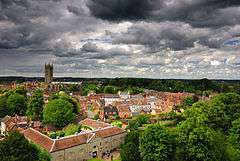 A view over Warwick | |
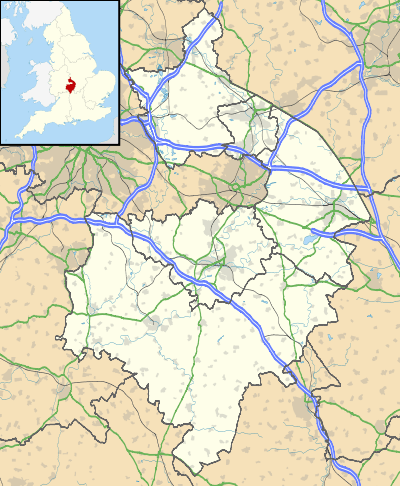 Warwick Location within Warwickshire | |
| Population | 31,345 |
| OS grid reference | SP2865 |
| Civil parish |
|
| District | |
| Shire county | |
| Region | |
| Country | England |
| Sovereign state | United Kingdom |
| Post town | WARWICK |
| Postcode district | CV34, CV35 |
| Dialling code | 01926 |
| Police | Warwickshire |
| Fire | Warwickshire |
| Ambulance | West Midlands |
| UK Parliament | |
History
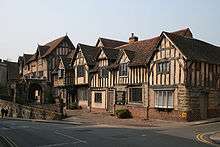
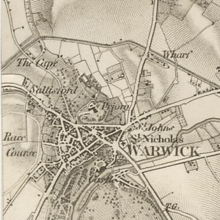
The name Warwick means "dwellings by the weir".[1]
Human activity on the site dates back to the Neolithic era, when settlement may have begun. Archaeological work on the site of Warwick School in 2017–2018 revealed the footings of a sizeable Roman barn from the 2nd century AD.[2] From the 6th century onwards, Warwick was continuously inhabited. The Anglo-Saxon Chronicle for the year 914 reports that the Anglo-Saxon Æthelflæd, Lady of the Mercians, daughter of king Alfred the Great and sister of king Edward the Elder of Wessex, built a burh or fortified dwelling there, as one of ten to defend Mercia from the Danes.[3] Warwick was chosen as a site for one burh because of its proximity to the transport routes of the Fosse Way and the Avon. In the early 10th century, a shire was founded with Warwick as its county town.[4] In 1016 the Danes invaded Mercia and burned down much of Warwick including a nunnery, which stood on the site of today's St Nicholas Church.[5]
William the Conqueror founded Warwick Castle in 1068, while on his way to Yorkshire to deal with rebellion in the north.[4] Building it involved pulling down four houses.[6] The castle stood within the larger Anglo-Saxon burh and a new town wall was created close to the burh ramparts.[7]
Medieval Warwick remained under the control of various Earls of Warwick, mostly of the Beauchamp family, becoming a walled town. The Hospital of St John was founded by Henry, Earl of Warwick at the east town gate.[8] Today the only remains of the town walls are the east and west gatehouses, the former now a holiday home, but previously part of the King's High School, a sister institution to Warwick School. Warwick was not incorporated as a borough until 1545.[5] The town's Priory was founded in 1142 on the site of the current Priory Park.
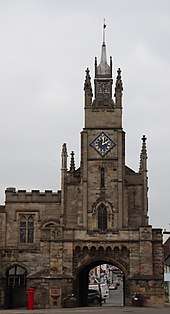
During the English Civil War the town and castle were garrisoned for Parliament. Under Sir Edward Peyto, it withstood a two-week siege by the Royalists. Later musters from 1644 to 1646 record a garrison of up to 350 men under the command of Colonel William Purefoy and Major John Bridges.
The mid-17th century saw the founding of Castle Hill Baptist Church, one of the oldest Baptist churches in the world.
Great Warwick fire
Much of the medieval town was destroyed in the Great Fire of Warwick of 1694.[9] Thus most of the town-centre buildings are of late 17th and early 18th-century origin, although some medieval timber-framed buildings survive, especially around the edges of the town centre.[10]
The fire burnt down much of the medieval church of St Mary; both the chancel and the Beauchamp Chapel, however, survived, the latter having been built between 1443 and 1464 according to the wishes of Richard Beauchamp, Earl of Warwick, who had died in Rouen in 1439. A full-size reclining copper-gilt effigy of him lies upon his Purbeck marble tomb – a fine piece of medieval metalwork cast in 1459.[11]
Possible city status
In 2008, the Coventry Telegraph reported that Warwick District Council would make a bid for city status for Warwick. According to the article, Councillor Michael Coker, later district council leader, said he would have been pleased to see anything that promoted Warwick.[12] As he put it, "I don't know how one goes into the process of applying for city status, but Warwick is a very ancient and important town.... Obviously it wouldn't be big enough to be a city in the governance sense, but if it were given the title I'd be happy to obtain it.... Locally we don't appreciate what a lovely town it already is."
There have been no further bids for city status since.
Notable people
Governance
Population growth has led to Warwick adjoining its larger neighbouring town, Leamington Spa, with which it forms a conurbation of some 95,000 inhabitants.[13] Both, along with Kenilworth and Whitnash, are now administered as part of Warwick District, which has its headquarters in Leamington, although each retains a separate town council. Warwickshire County Council remains based in Warwick itself.
Warwick is represented in Parliament as part of the Warwick and Leamington constituency. It has been held by the Labour Party since the 2017 general election, when Matt Western was elected as the constituency's Member of Parliament. From the 1945 general election until 1997 the constituency elected a Conservative MP. In 1997 a Labour MP was elected and held the seat until 2010 when Chris White was elected for the Conservatives.[14] White lost his seat when Theresa May called a snap election in 2017.
Geography

The 17th-century antiquarian William Dugdale wrote that Warwick was "standing upon a rocky ascent from every side, and in a dry and fertile soil, having... rich and pleasant meadows on the south part... and... woodland on the north."[15] Two factors have affected Warwick's built environment: the Great Fire of 1694 and the lack of industrialisation. In the 19th century, the widespread industrialisation of England largely passed Warwick by.[16] One reason was that the town did not lie on important roads and the River Avon was not navigable as far as Warwick.[17]
Suburbs
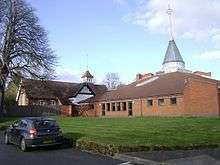
Suburbs of Warwick include Bridge End, Cliff Hill, Emscote, Forbes, Myton (connecting Warwick with Leamington Spa), Packmores, The Cape, The Percy, Warwick Gates, Woodloes Park and the newly established Chase Meadow.
Warwick Gates and Chase Meadow
Warwick Gates is a housing estate and business park in Heathcote, south-east Warwick, which was built in the late 1990s. Although separated from Warwick town centre by open fields, Warwick Gates falls within the Warwick South and Bishops Tachbrook parish. It is adjacent to Whitnash, a small town near Leamington Spa, and the village of Bishops Tachbrook. The Tachbrook Park and Heathcote industrial estates are also nearby. The NHS Royal Leamington Spa Rehabilitation Hospital is adjacent to Warwick Gates.
In the early 2010s another new estate, Chase Meadow, was built to the south-west of the town next to Warwick Racecourse. Its amenities include a public house, a Chinese takeaway and a fish and chip shop.
Climate
Warwick experiences the usual English maritime climate, marked by a narrow temperature range, mild winters and cool summers. The nearest official Met Office weather station is at Wellesbourne, about 6 miles (10 km) south of the town centre and at a similar elevation.
The absolute maximum temperature (also the absolute maximum for the county of Warwickshire) stands at 36.1 °C (97.0 °F)[18] recorded in August 1990. During a typical year, the warmest day should reach 30.0 °C (86.0 °F),[19] and 16.5 days[20] should report a maximum of 25.1 °C (77.2 °F) or higher.
The lowest recorded temperature is −17.8 °C (0.0 °F),[21] recorded in January 1982. Typically, 53.3 air frosts are recorded in an "average" year.
Rainfall averages out at 608 millimetres (23.9 in) per year,[22] with over 114 days[23] seeing 1 mm (0.04 in) or more falling. All averages refer to the 1971–2000 period.
| Climate data for Wellesbourne, elevation 47 m (154 ft), 1971–2000, extremes 1960– | |||||||||||||
|---|---|---|---|---|---|---|---|---|---|---|---|---|---|
| Month | Jan | Feb | Mar | Apr | May | Jun | Jul | Aug | Sep | Oct | Nov | Dec | Year |
| Record high °C (°F) | 14.5 (58.1) |
17.8 (64.0) |
21.7 (71.1) |
26.3 (79.3) |
28.1 (82.6) |
32.8 (91.0) |
35.4 (95.7) |
36.1 (97.0) |
28.9 (84.0) |
23.9 (75.0) |
18.8 (65.8) |
15.6 (60.1) |
36.1 (97.0) |
| Average high °C (°F) | 7.0 (44.6) |
7.5 (45.5) |
10.2 (50.4) |
12.8 (55.0) |
16.5 (61.7) |
19.4 (66.9) |
22.4 (72.3) |
21.9 (71.4) |
18.4 (65.1) |
14.1 (57.4) |
9.8 (49.6) |
7.7 (45.9) |
14.0 (57.2) |
| Average low °C (°F) | 0.9 (33.6) |
0.8 (33.4) |
2.4 (36.3) |
3.6 (38.5) |
6.2 (43.2) |
9.1 (48.4) |
11.3 (52.3) |
11.2 (52.2) |
9.3 (48.7) |
6.5 (43.7) |
3.2 (37.8) |
1.7 (35.1) |
5.5 (41.9) |
| Record low °C (°F) | −17.8 (0.0) |
−14.5 (5.9) |
−10 (14) |
−6.6 (20.1) |
−2.8 (27.0) |
−1.7 (28.9) |
2.2 (36.0) |
1.7 (35.1) |
−2.2 (28.0) |
−5.7 (21.7) |
−8.5 (16.7) |
−17.4 (0.7) |
−17.8 (0.0) |
| Average precipitation mm (inches) | 53.84 (2.12) |
39.86 (1.57) |
45.27 (1.78) |
44.86 (1.77) |
49.3 (1.94) |
53.57 (2.11) |
44.75 (1.76) |
56.32 (2.22) |
57.58 (2.27) |
54.97 (2.16) |
50.18 (1.98) |
57.77 (2.27) |
608.46 (23.96) |
| Source: KNMI[24] | |||||||||||||
Demography
| Warwick[25] | Warwick District[26] | England | |
|---|---|---|---|
| Total population | 23,350 | 125,931 | 49,138,831 |
| White | 93.9% | 92.9% | 90.9% |
| Asian | 3.8% | 4.7% | 4.6% |
| Black | 0.4% | 0.5% | 2.3% |
At the 2001 UK census, Warwick had a population of 23,350. The population density was 8,841 per square mile (3,414/km2), with a 100 to 95.7 female-to-male ratio.[27] Of those over 16 years old, 29.0% were single (never married), 43.4% married or widowed, and 8.9% divorced.[28] Warwick's 10,285 households included 33.1% one-person, 36.7% married couples living together, 8.6% were co-habiting couples, and 16.8% single parents with their children; these figures were similar to those of the wider district of Warwick, however both borough and town had higher rates of single parents than England (9.5%).[29] Of those aged 16–74, 26.2% had no academic qualifications, above the figure for the district but below the proportion nationally (22.2% and 28.9% respectively), and 26.2% had an educational qualification such as a first degree, higher degree, qualified teacher status, medical, dentistry or nursing qualifications, those for midwives and health visitors, etc., compared to 19.9% nationwide.[30][31]
Population change
Before the 1801 census, populations were not directly recorded. However estimates can be based on other measures. Historians suggest that in 1086 the town had a population of around 1,500. Indicators for the following centuries are sparse, but it is estimated that the population in the mid-16th century was around 2,000. By the late 17th century this had increased to over 3,000. The 1801 census recorded that 5,592 people lived in Warwick.[32]
Economy
Due to its proximity to north-south and east-west motorway routes, many companies have a head office in the town. Since November 2004, National Grid plc has had its UK headquarters on the Warwick Technology Park south of the town between the A425 road and A452 road. Phillips 66 and their petrol station group, JET, have an office on the Technology Park. Other businesses with head offices here include lingerie company Bravissimo. IBM, Gerflor and Volvo Group UK have bases on the Wedgnock Industrial Estate in the north of the town, near to the A46 trunk road. Other companies with regional headquarters in Warwick include Bridgestone, Calor, Kantar and Delphi Automotive. In recent years several high-profile national and international companies have set up large office complexes in and around Warwick, notably National Grid plc and IBM.
Culture
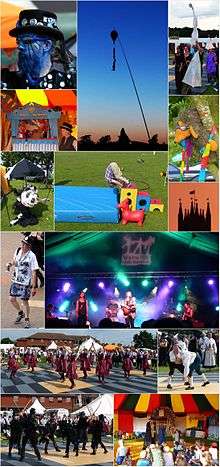
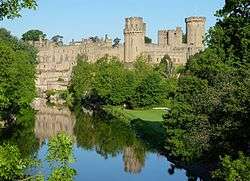
Warwick hosts several annual festivals, including: the Spoken Word; Classical and Contemporary Music; a Folk Festival; and a Victorian Evening, held in late November or early December. St. Mary's Church hosts a series of Early Music concerts, and the Bridge House Theatre hosts the Music-in-Round concerts. Warwick Chamber of Trade helps to promote the town for visitors, residents and businesses. The town is also famous for Warwick Castle, whose construction began in 1068. The town centre is also known for its mixture of Tudor and 17th-century buildings.
Warwick is also known for Warwick Racecourse, near the west gate of the medieval town, which hosts several televised horse racing meetings a year. Within the racecourse is a small golf course. J. R. R. Tolkien seems to have been very influenced by Warwick (where he was married in the Catholic Church of Saint Mary Immaculate) and by its Mercian connections: Lynn Forest-Hill, in an article in the Times Literary Supplement (TLS 8 July 2005 pp 12–13) argues cogently that two important settlements in Tolkien's work were modelled on Warwick — Edoras closely on the early town, and Minas Tirith more remotely on the Norman; and that aspects of the plot of The Lord of the Rings are paralleled in the romance known as Guy of Warwick. Christopher Tolkien, in The Book of Lost Tales, stated that Kortirion, the main city of Tol Eressëa, "would become in after days Warwick."
Warwick and its historic buildings have featured in a number of television series, including the BBC's drama series Dangerfield, the period dramas Pride and Prejudice and Tom Jones and Granada Television's Moll Flanders. Parts of the town substituted for Elizabethan and Jacobean era London in the third-series episode two ("The Shakespeare Code") of Doctor Who which ran 7 April 2007. Filming took place in June 2019 for A Christmas Carol,[33] which was screened on UK television at Christmas 2019.[34]
Hospitals
Warwick Hospital, Royal Leamington Spa Rehabilitation Hospital and St Michael's Hospital (a psychiatric unit that superseded Central Hospital, Hatton) are in the town.
Sport
Warwick Racecourse is located just west of the town centre. Adjacent to it is Racing Club Warwick F.C., founded in 1919. The city has many long-established sports clubs, including Warwick Hockey Club, founded in 1920.
Education
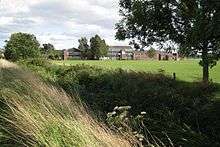
Schools
There are a number of secondary schools located within Warwick, including Warwick School, an independent day school for boys (with a small boarding department), The King's High School For Girls, an independent day school for girls, Myton School and Aylesford School, both of which are state run co-educational schools. Campion School and Trinity Catholic School in Leamington Spa include parts of Warwick in their priority areas.[35] Warwick Preparatory School is an independent day school and nursery for boys aged 3–7 and girls 3–11.[36] It is part of the Warwick Independent Schools Foundation, together with King's High School and Warwick School.
Warwick School
Warwick School is an independent school for boys which claims to be the oldest boys' school in England.[37] The actual date of its founding is unknown, although 914 has sometimes been quoted. For some years the school claimed that King Edward the Confessor (c.1004–1066) chartered it, although there is no direct evidence for this, and King Henry VIII re-founded the school in 1545. Whatever the truth of the matter, there is no doubt that there has been a grammar school in the town of Warwick since before the Norman Conquest, and its successor, the present independent school, has been on its current site south of the River Avon since 1879.
University of Warwick
The nearest university is the University of Warwick, which is named after the county of Warwickshire, rather than the town, and is in fact situated several miles north of Warwick on the southern outskirts of Coventry. Adding to the location confusion is the fact that Coventry is no longer in the county of Warwickshire, but instead is in the West Midlands, leading to the current situation where the university straddles both counties.
Landmarks
- Collegiate Church of St Mary
- Lord Leycester Hospital
- Lord Leycester Hotel
- Market Hall
- Guy's Cliffe House
- Market Square
- The Dream Factory
- St John's Museum
- St Michael's Leper Hospital
- St. Nicholas' Park
- Saxon Mill
- Shire Hall
- Warwick Castle
- Warwick Hospital
- Warwick Racecourse
- Warwick School
- Hill Close Gardens
Transport
Road

Warwick is on the M40 London-Birmingham motorway, connected to junctions 13, 14 and 15, and is on the A46 dual-carriageway trunk road positioned between Coventry and Stratford-upon-Avon. Warwick has several council off-street car parks in the town.[38] There are also a few privately run car parks, including those at the railway station and the castle.
Railway
The town has a railway station with direct rail services to Leamington Spa, London, Birmingham and Stratford-upon-Avon provided by Chiltern Railways. In addition, a few peak-hour trains to and from Birmingham are operated by West Midlands Trains. Warwick Parkway, an out-of-town station opened in 2000 to the west of the town, providing faster commuter services to London (c. 1 hour 10 minutes) and Birmingham. Historically the Leamington & Warwick Tramways & Omnibus Company operated between the towns from 1881 to 1930.
Bus
Bus services to Leamington Spa, Stratford-upon-Avon and Coventry are operated by Stagecoach in Warwickshire from the bus station in the town centre.
Coach
There is also a National Express coach stop in the town's bus station with limited services. The nearby Warwick Parkway railway station also has a coach stop with more frequent services.
Waterways
The Grand Union Canal and the River Avon also pass through the town. The restored Saltisford Canal Arm is close to the town centre. It is a short branch of the Grand Union Canal, the remains of the original terminus of the Warwick and Birmingham Canal. It dates back to 1799. The Saltisford Canal Trust has restored most of the surviving canal, which is now the mooring for colourful narrowboats and a waterside park open to the public. Over 800 visiting narrowboats come by water to Warwick each year and moor on the arm.
Air
The nearest international airport to Warwick is Birmingham Airport, about 20 miles (32 km) by road from the town centre. There also used to be an RAF station called RAF Warwick.
Twin towns
The town of Warwick has formal twinning arrangements with two European towns: Saumur in France (since 1976) and Verden in Germany (since 1989). Havelberg in Germany has been a friendship town since 1990 when it was adopted by Verden.[39] There is also a friendship link with Bo District in Sierra Leone.[40]
References
- Notes
- Warwickshire History, Warwickshire County Council, archived from the original on 1 October 2011, retrieved 2 April 2011
- "Rare Roman find unearthed at new school building site – Stratford Herald". 7 February 2018.
- Anglo-Saxon Chronicle, ed. M. Swanton (Dent, London 1997), s. a., pp. 911–918.
- Allison, Dunning & Jones 1969, p. 418
- Slater 1981
- Harfield 1991, pp. 373, 382
- Allison, Dunning & Jones, pp. 418–419
- "Hospitals: Warwick." A History of the County of Warwick: Volume 2, ed. William Page. London: Victoria County History, 1908, pp. 115–117. British History Online website Retrieved 4 May 2020.
- The governing charter of the borough of Warwick, Joseph Parks (1827), p. 51.
- Allen 2000
- Encyclopædia Britannica. Retrieved 4 May 2020.
- Thomas, Helen (15 April 2008). "Warwick set to make bid for city status". Coventry Telegraph. Retrieved 24 December 2019.
- "UNITED KINGDOM: Urban Areas in England". City Population. Retrieved 8 April 2018.
- "Warwick and Leamington", The Guardian, retrieved 3 April 2011
- Quoted in Allison, Dunning & Jones 1969, p. 417
- Pevsner & Wedgwood 1996, p. 443
- Allison, Dunning & Jones 1969, p. 417
- "1990 maximum". Retrieved 28 February 2011.
- "Annual average maximum". Retrieved 28 February 2011.
- "Days >25c average". Retrieved 28 February 2011.
- "1982 minimum". Retrieved 28 February 2011.
- "1971-00 Rainfall". Retrieved 28 February 2011.
- "1971-00 Raindays". Retrieved 28 February 2011.
- "Climate Normals 1971–2000". KNMI. Retrieved 28 February 2011.
- KS06 Ethnic group: Census 2001, Key Statistics for urban areas, Statistics.gov.uk, 25 January 2005, archived from the original on 4 August 2009, retrieved 2 April 2011
- Warwick (Local Authority) ethnic group, Statistics.gov.uk, retrieved 2 April 2011
- KS01 Usual resident population: Census 2001, Key Statistics for urban areas, Statistics.gov.uk, 7 February 2005, archived from the original on 6 December 2010, retrieved 2 April 2011
- KS04 Marital status: Census 2001, Key Statistics for urban areas, Statistics.gov.uk, 2 February 2005, archived from the original on 29 July 2009, retrieved 2 April 2011
- KS20 Household composition: Census 2001, Key Statistics for urban areas, Statistics.gov.uk, 2 February 2005, archived from the original on 4 August 2009, retrieved 2 April 2011
•Warwick (Local Authority) household data, Statistics.gov.uk, retrieved 12 September 2008 - Warwick (Local Authority) key statistics, Statistics.gov.uk, retrieved 2 April 2011
- KS13 Qualifications and students: Census 2001, Key Statistics for urban areas, Statistics.gov.uk, 2 February 2005, archived from the original on 4 August 2009, retrieved 2 April 2011
- Allison, Dunning & Jones 1969, pp. 417–418
- https://www.birminghammail.co.uk/news/showbiz-tv/bbcs-christmas-carol-filming-warwickshire-16392062
- https://www.bbc.co.uk/news/newsbeat-50824672
- "Secondary school priority areas: Central area" (PDF). Warwickshire County Council. Archived from the original (PDF) on 13 September 2011.
- "Warwick Preparatory School". Retrieved 14 February 2017.
- About us, Warwick School, retrieved 15 March 2012
- "Parking in Warwick". Warwick District Council. 1 January 2011.
- Twinning, Warwick District Council, archived from the original on 20 October 2013, retrieved 3 April 2011
- One World Link, One World Link, retrieved 3 April 2011
- Bibliography
- Allen, Geoff (2000), Warwickshire Towns & Villages, Sigma Leisure, ISBN 1-85058-642-X
- Allison, K. J.; Dunning, R. W.; Jones, S. R. (1969), "The Borough of Warwick: Introduction", in Stephens, W. B. (ed.), A History of the County of Warwick: Volume 8: The City of Coventry and Borough of Warwick, Victoria County History, pp. 417–451, ISBN 0-19-722734-1
- Harfield, C. G. (1991), "A Hand-list of Castles Recorded in the Domesday Book", English Historical Review, 106: 371–392, doi:10.1093/ehr/CVI.CCCCXIX.371, JSTOR 573107
- Pevsner, Nikolaus; Wedgwood, Alexandra (1996) [1966], Warwickshire, The Buildings of England, Penguin Books, ISBN 0-14-071031-0
- Slater, Terry (1981), A History of Warwickshire, Phillimore, ISBN 0-85033-416-0
Further reading
- Allison, K. J. (1969a), "The Borough of Warwick: Political and Administrative History to 1545", in Stephens, W. B. (ed.), A History of the County of Warwick: Volume 8: The City of Coventry and Borough of Warwick, Victoria County History, pp. 476–480, ISBN 0-19-722734-1
- Allison, K. J. (1969b), "The Borough of Warwick: Economic and Social History to 1545", in Stephens, W. B. (ed.), A History of the County of Warwick: Volume 8: The City of Coventry and Borough of Warwick, Victoria County History, pp. 480–489, ISBN 0-19-722734-1
External links
| Wikimedia Commons has media related to Warwick, England. |
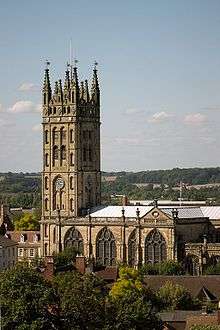
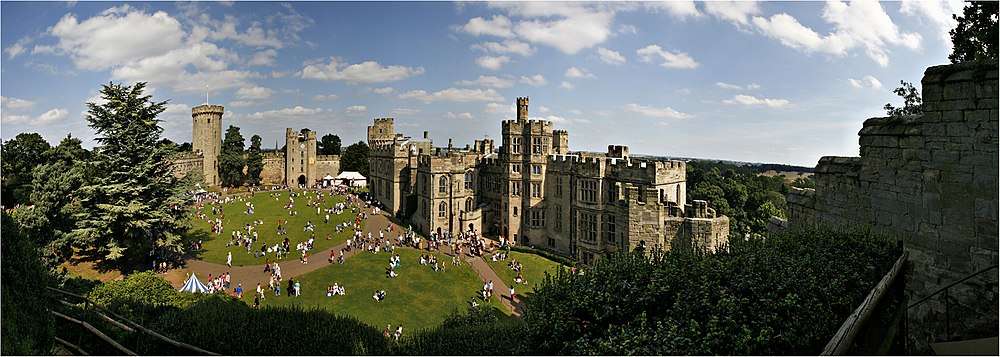
_-_geograph.org.uk_-_1583289.jpg)
